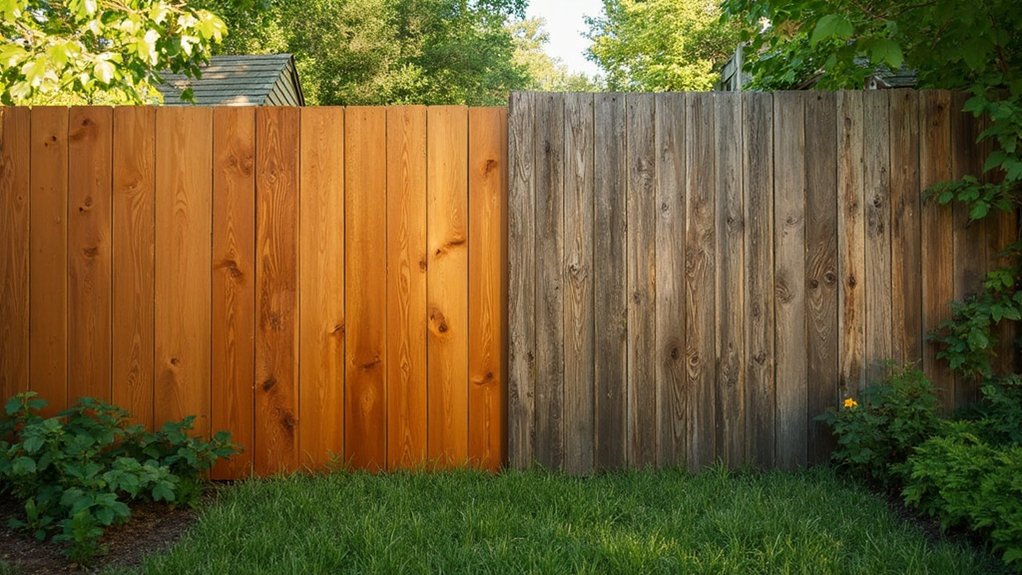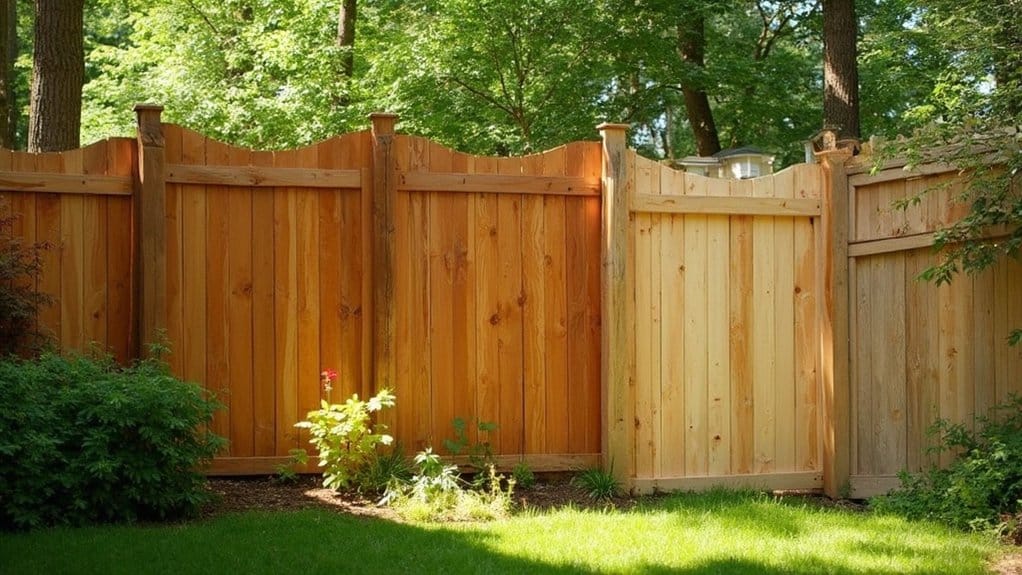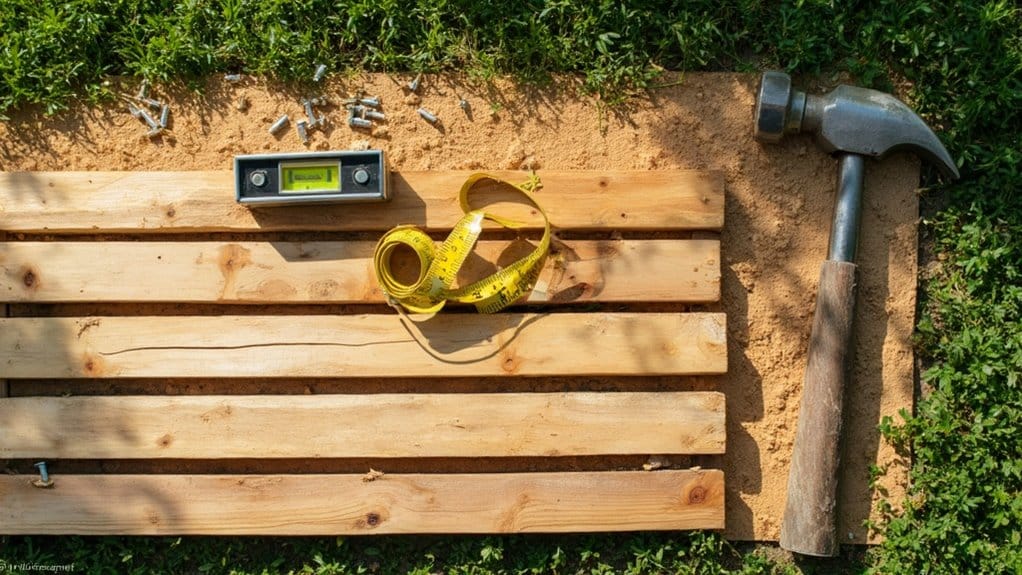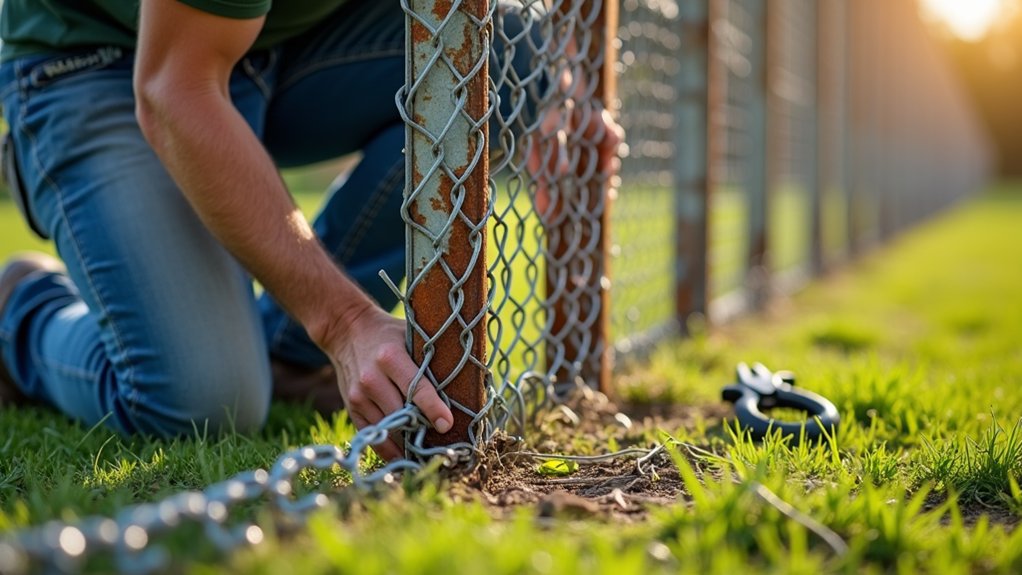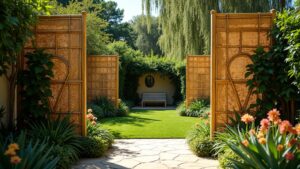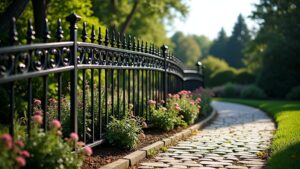When comparing composite and wood fencing, composite stands out for its longevity. It lasts 20-30 years, while wood only lasts 10-20 years. Composite is resistant to rot, pests, and harsh weather, making it a low-maintenance option, whereas wood needs regular upkeep and can easily be damaged. Although composite has a higher upfront cost, its durability means you’ll save money in the long run. For more insights on costs and aesthetics, feel free to ask!
Key Takeaways
Composite fencing outlasts wood fencing, lasting 20-30 years compared to wood’s 10-20 years. It stands up to rot, pests, and harsh weather without warping or cracking.
Wood requires regular maintenance, which can add to long-term costs. In contrast, composite fencing needs fewer repairs and replacements, making it more cost-effective over time. Plus, composite materials are often recycled, making it a greener choice with a longer lifespan than wood.
Overview of Composite Fencing
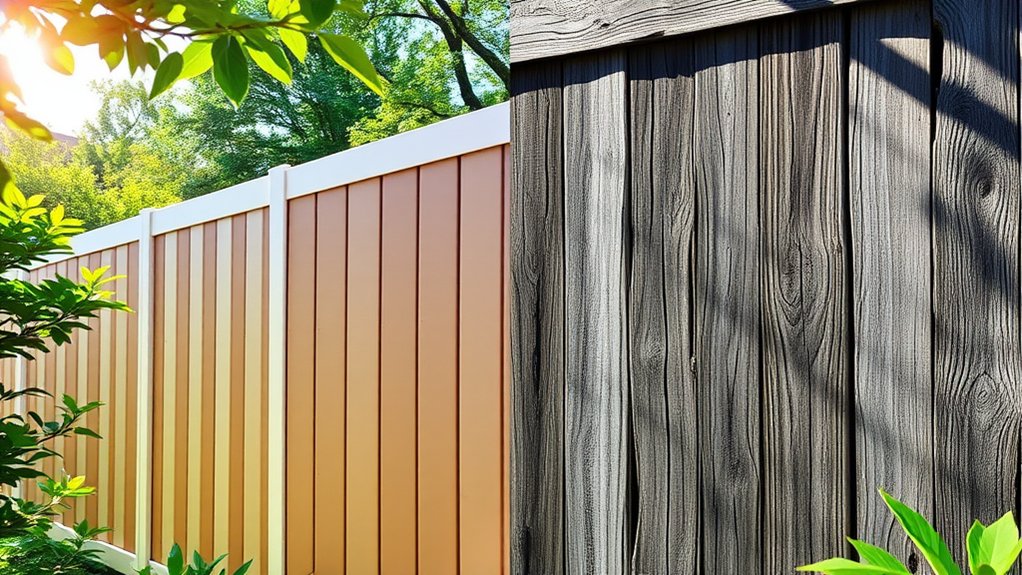
Composite fencing is a modern, eco-friendly alternative to traditional wood fencing. Made from recycled wood fibers and plastic polymers, it looks like wood but offers greater durability. With a lifespan of 20-30 years, it resists rot, pests, and weather damage, making it suitable for various climates. One of its main advantages is low maintenance; there’s no need for staining or painting. Although the initial cost is higher than wood, the savings on maintenance and replacements over time make it a smart investment. Plus, by using composite materials, you’re helping reduce deforestation, making it a responsible choice compared to conventional wood fencing. Additionally, composite fencing is highly durable and does not warp, crack, or splinter over time, further enhancing its appeal for homeowners.
Overview of Wood Fencing
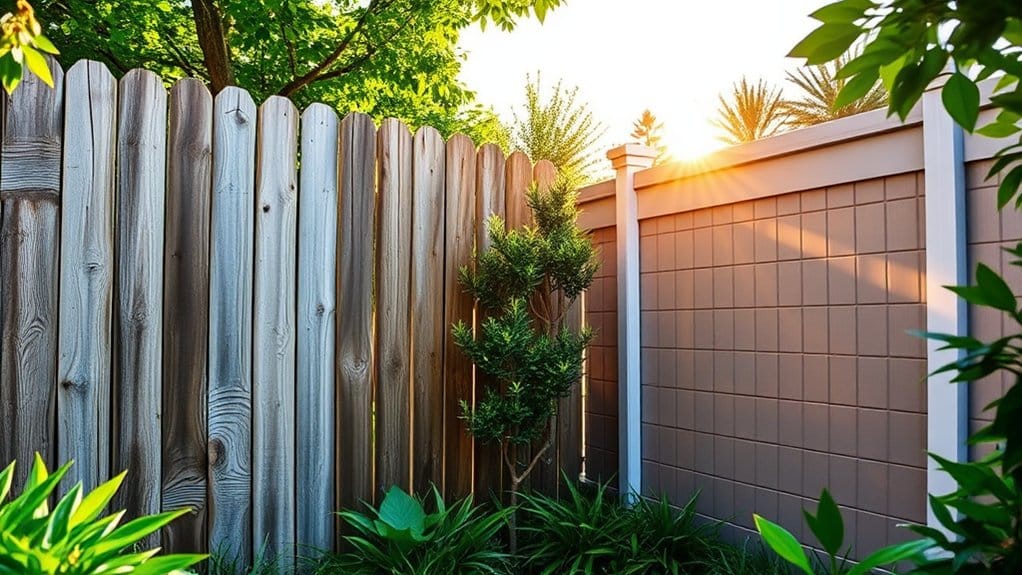
Wood fencing is a classic choice for homeowners who want a natural look. With different styles available, you can easily find one that fits your property.
Here are the main components to consider:
- Posts: These are the vertical supports that keep the fence sturdy.
- Rails: Horizontal pieces that connect the posts.
- Pickets or Boards: These are the visible parts of the fence.
- Kickboards: Optional pieces that help protect against moisture.
To make your wood fence last, regular maintenance is key. A well-cared-for fence can last 10-15 years. Posts and rails work together to maintain the fence’s integrity, ensuring it withstands the elements over time. Additionally, wood fencing typically requires higher repair frequency compared to materials like PVC, which can outlast wood by several decades. Check for any damage or rot, and apply protective finishes to enhance durability. Whether you choose pressure-treated pine or naturally resistant cedar, your selection will affect both the fence’s lifespan and appearance.
Durability of Composite Fencing
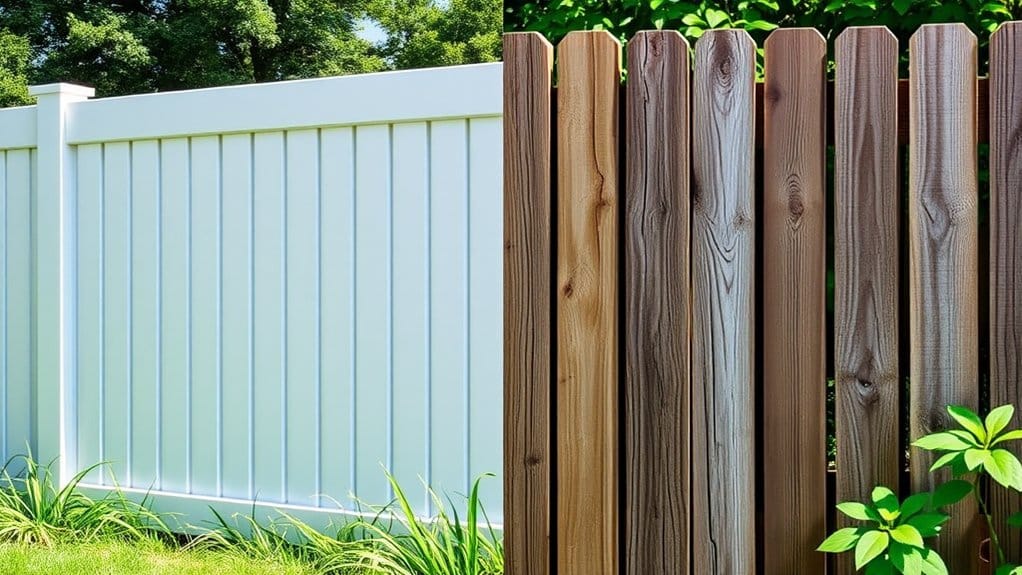
Composite fencing is a top choice for homeowners looking for durability.
With a lifespan of 20-30 years, it outlasts traditional wood fences. Made from a mix of recycled wood fibers and plastic, it’s designed to resist harsh weather like heavy rain, snow, and intense sunlight without warping or cracking.
Unlike wood, composite fencing won’t rot, attract insects, or mold. Plus, built-in UV inhibitors help prevent color fading. This means fewer repairs and replacements, making composite fencing a smart, low-maintenance investment for any homeowner. Additionally, the durability and longevity of composite materials ensures they provide value over decades compared to wood options.
Durability of Wood Fencing
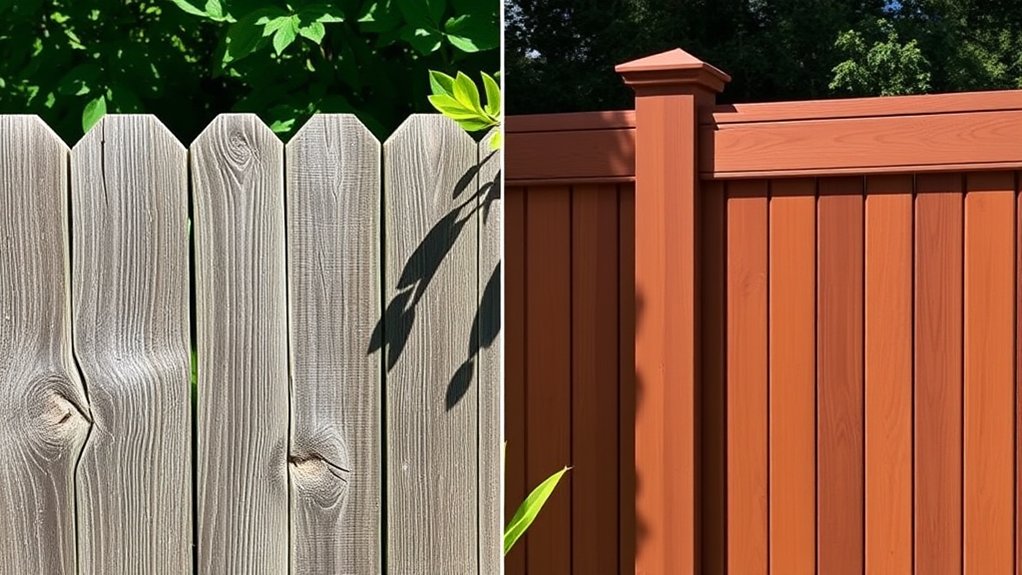
When choosing a fence, wood fencing lasts about 10 to 20 years, influenced by maintenance and the environment.
To help your wood fence last longer, consider these tips:
- Annual Inspections: Check for issues early to avoid expensive repairs.
- Prompt Repairs: Fix any damages quickly to keep it strong.
- Cleaning and Sealing: Use sealants to guard against moisture and decay.
- Staining and Painting: Improve its look while protecting it from the weather.
The durability of your fence also depends on factors like climate, wood quality, and materials like cedar or pressure-treated pine. Additionally, proper maintenance can extend lifespan to 15-20 years.
Following these steps can effectively extend your wood fence’s life.
Cost Analysis of Composite Fencing
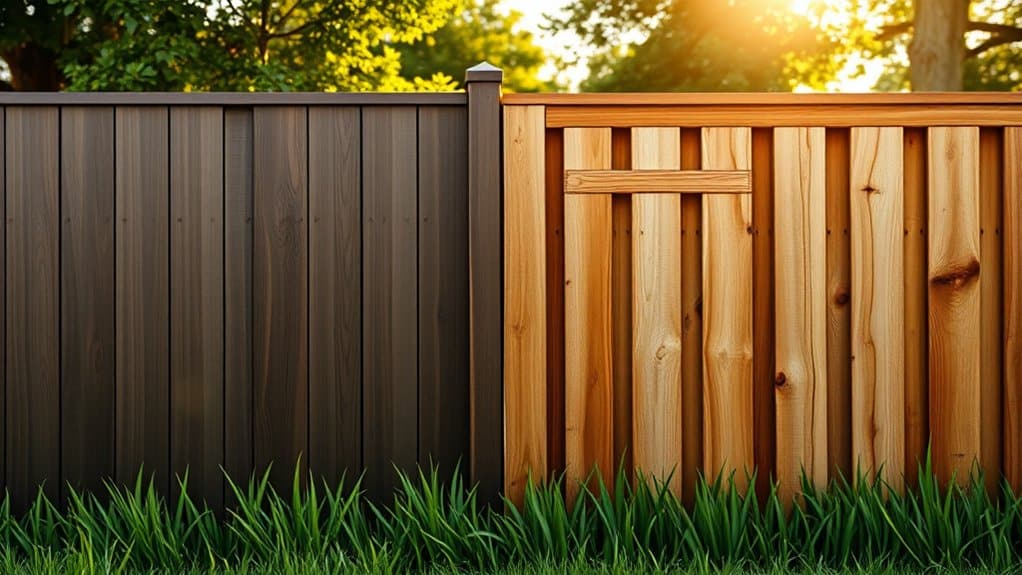
When exploring fencing options, it’s important to understand the costs associated with composite fencing. Prices for materials range from $9 to $43 per linear foot, with installation adding another $2 to $6 per linear foot.
On average, a fully installed composite fence costs about $28 per linear foot. While this is pricier than wood fencing, which costs between $15 and $25 per linear foot, composite fencing offers long-term savings due to its durability and low maintenance. Additionally, the lifespan of composite materials often exceeds 20 to 30 years, making it a worthwhile investment for homeowners.
Keep in mind that factors like height, material quality, and additional features can affect overall costs.
Cost Analysis of Wood Fencing
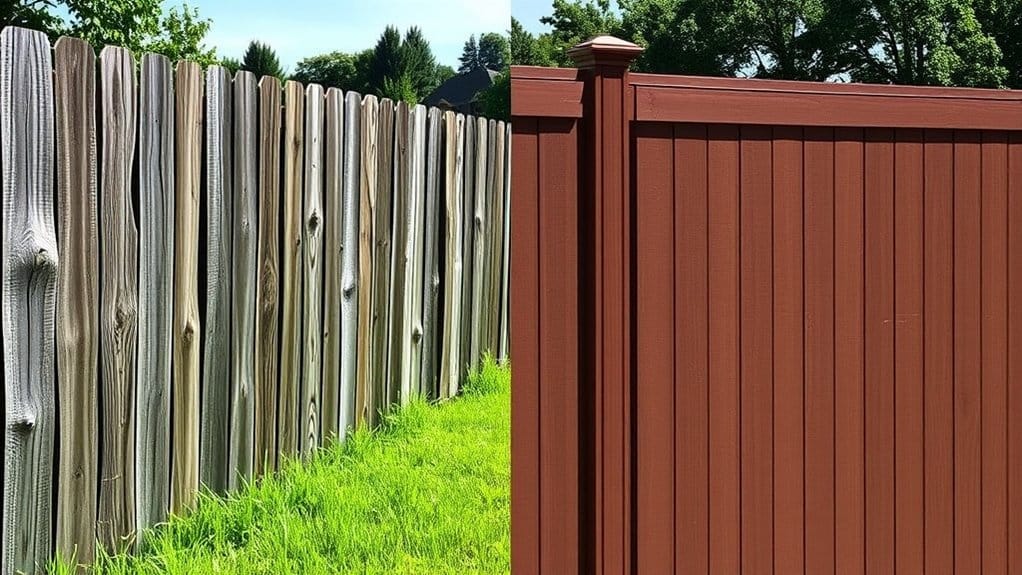
When looking at wood fencing, it’s important to assess three key costs: initial installation, ongoing maintenance, and long-term expenses.
Installation costs can differ widely depending on the type of wood and labor you choose. For example, a cedar fence might cost more upfront but require less maintenance than a cheaper option.
Over time, maintenance—like staining or treating the wood—can add to your budget. By weighing these factors, you can make a smart choice that aligns with your financial situation and needs. Additionally, the long-lasting nature of wood reduces overall replacement costs.
Initial Investment Considerations
When considering the initial investment for wood fencing, installation costs typically range from $1,920 to $4,821, with an average of about $3,220.
Here are key factors to consider:
- Cost Per Linear Foot: Expect to pay $20 to $50 per linear foot.
- DIY Savings: Installing it yourself can save you about 50%, bringing costs down to $850 to $2,200.
- Terrain Impact: Uneven land may lead to higher preparation costs.
- Wood Type: Cedar is more expensive than pine, affecting your overall budget.
Understanding these factors will help you plan your wood fencing project effectively. Additionally, it’s important to note that vinyl fences offer a more durable and low-maintenance alternative compared to wood options.
Ongoing Maintenance Expenses
Maintaining a wood fence comes with ongoing costs that can affect your budget. Every 3 to 5 years, you’ll need to spend between $300 and $600 for staining or sealing.
Regular inspections are crucial to catch pests and rot early; otherwise, repairs can get expensive. If you find pest damage, expect to pay an additional $100 to $300.
Weather can also take a toll, with repairs from wind or moisture ranging from $100 to $500. To keep expenses down, consider using treated wood and protective coatings.
Each maintenance task adds to your total investment in your wood fence.
Long-Term Cost Implications
Ongoing maintenance costs significantly affect the long-term financial implications of wood fencing. Here are key points to consider:
- Initial installation: Wood fencing costs between $20 and $50 per linear foot, varying by wood type.
- Maintenance: Regular upkeep, such as staining and repairs, is needed every 1-3 years.
- Lifespan: With proper care, wood fences last 10-20 years, which may lead to replacements.
- Long-term costs: Over time, maintenance and replacement costs can surpass initial savings.
Environmental Impact of Composite Fencing
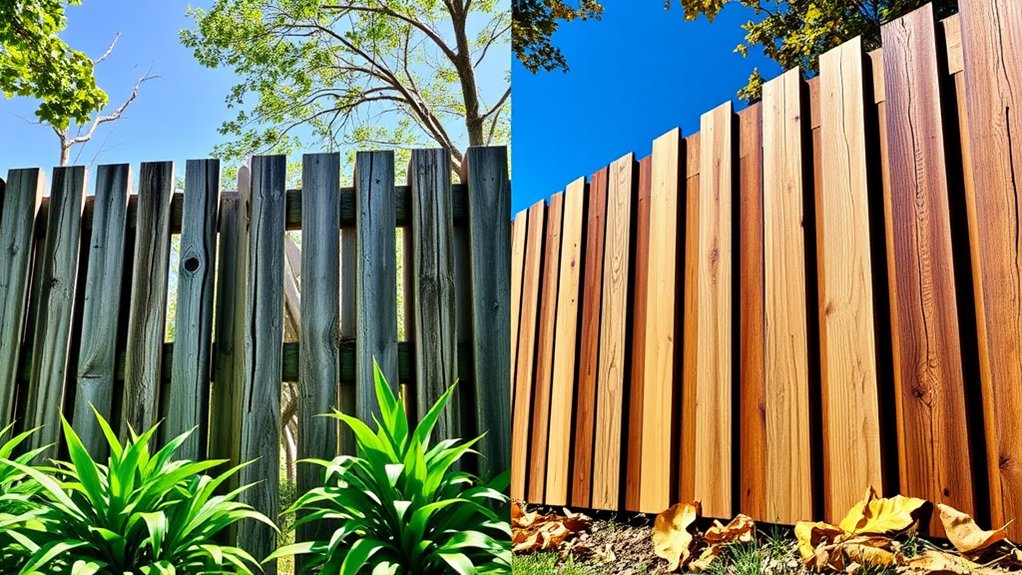
Composite fencing is an eco-friendly choice due to its use of 95% recycled materials.
This not only reduces waste but also helps conserve natural resources.
By choosing composite over traditional wood fencing, you contribute to less landfill waste and support sustainable practices.
It’s a smart way to enhance your outdoor space while being kind to the planet.
Recycled Material Benefits
Composite fencing is a great choice for those looking to reduce their environmental impact.
Here are some key benefits of using composite materials:
- High recycled content: With 95% of its composition coming from reclaimed wood and plastic, it cuts down on the need for new resources.
- Repurposed waste: It transforms items like grocery bags and plastic film into useful fencing.
- Protects forests: By reducing the demand for new lumber, it helps conserve important ecosystems.
- Reduced carbon footprint: Local sourcing means lower transportation emissions, which is better for the planet.
Choosing composite fencing not only enhances your property but also supports sustainable practices while providing a durable and attractive option.
Reduced Waste Contribution
When choosing fencing, consider composite options for their environmental benefits.
Composite fences last 20-30 years, far outlasting wood fences, which generally last 10-15 years. This durability means less waste from frequent replacements.
Additionally, installing composite fencing creates less material waste than wood, requiring fewer resources and reducing transport fuel consumption.
Unlike wood, composite fences don’t need chemical treatments, which lessens environmental harm.
Sustainable Sourcing Practices
Choosing composite fencing not only beautifies your property but also shows your commitment to sustainability. Here’s how:
- Reduced Environmental Impact: Composite fencing is made from recycled wood fibers and plastic, cutting down the need for new materials.
- Resource Conservation: Using recycled materials helps prevent deforestation and supports sustainable sourcing.
- Eco-Friendly Production: The manufacturing process is energy-efficient, resulting in lower emissions compared to traditional wood.
- Recyclability: When it’s time to replace your fence, composite materials can be recycled, further promoting sustainability.
In short, composite fencing is an excellent choice for homeowners who care about the environment while maintaining aesthetic appeal.
Environmental Impact of Wood Fencing
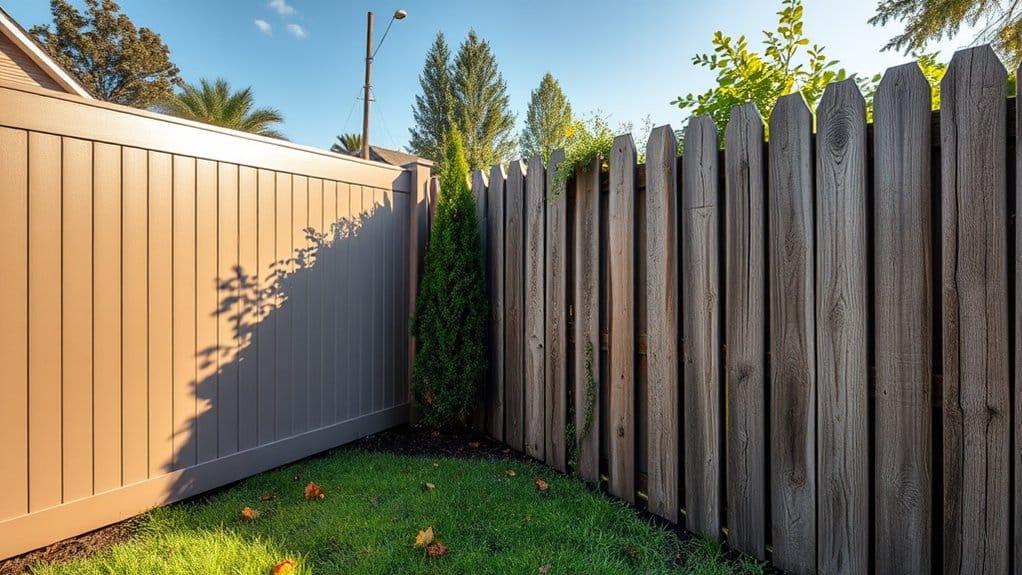
Wood fencing can beautify homes, but its environmental impact is significant. The demand for timber leads to deforestation and loss of habitats, so it’s crucial to choose wood from certified sources like FSC or PEFC to support sustainable practices.
Many wood fences are treated with chemicals that can harm local wildlife, so consider using natural oils as a safer alternative.
Production and transportation also contribute to carbon emissions, so buying locally can help reduce your carbon footprint.
Aesthetic Appeal of Composite Fencing
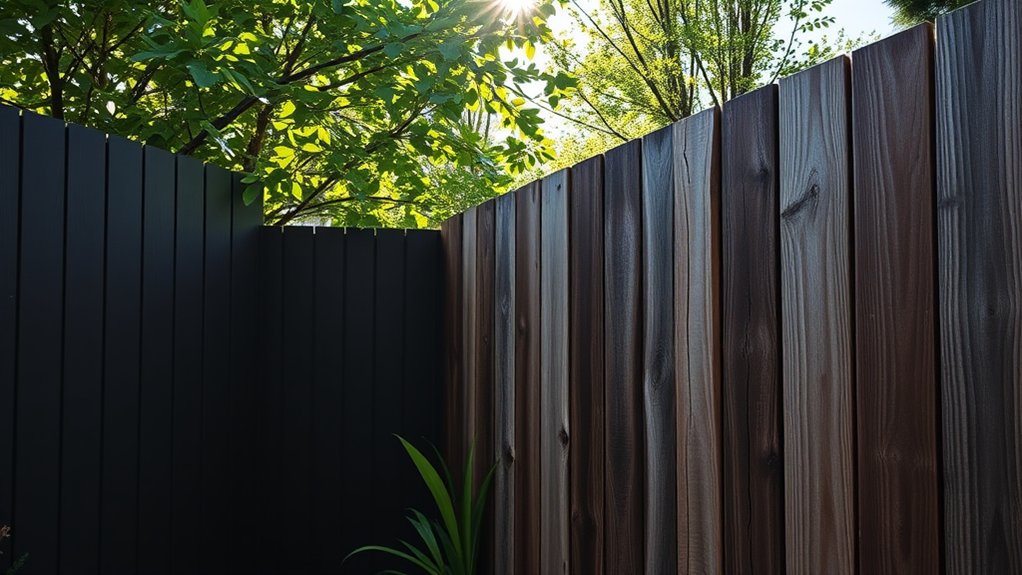
Composite fencing is a great choice for aesthetic appeal, offering a range of colors to match any home style.
It looks like natural wood but won’t fade or warp over time. This means your fence will stay attractive for years, making it a smart and stylish investment.
Color Variety Options
Composite fencing offers a wide range of color choices, making it a great option for homeowners who want to enhance their property’s appearance.
Here are some popular colors:
- Grey
- Cedar Red
- Charcoal
- Redwood
Many manufacturers also offer customization beyond these standard colors, allowing you to tailor your fence to your style.
Made from recycled plastic and wood fibers, composite fencing maintains its color over time without fading.
Plus, with a factory-finished surface, there’s no need for painting or staining, making it a low-maintenance and attractive choice for any home.
Natural Look Mimicking
Composite fencing offers homeowners a perfect mix of beauty and durability by closely resembling natural wood.
It comes in various styles and textures that blend well with your landscape, whether your home is traditional or modern.
With a range of colors and finishes, you can achieve a consistent look without the imperfections of real wood.
Plus, customizable heights and designs let you create unique layouts that enhance your property’s appeal while providing security.
Long-lasting Color Retention
Homeowners looking for a durable fencing option will appreciate the long-lasting color retention of composite materials.
Unlike wood, composite fencing resists fading, keeping your fence vibrant for years. Here are some key points to maintain its appearance:
- UV Protection: Composite materials are treated with UV agents to prevent fading from sunlight.
- Non-Porous Surface: This feature helps resist stains, preserving the color.
- Minimal Maintenance: A quick clean with a soft brush keeps your fence looking new.
- Strategic Trimming: Regularly trim nearby greenery to reduce debris and staining risks.
Choose composite fencing for a beautiful, low-maintenance solution!
Aesthetic Appeal of Wood Fencing
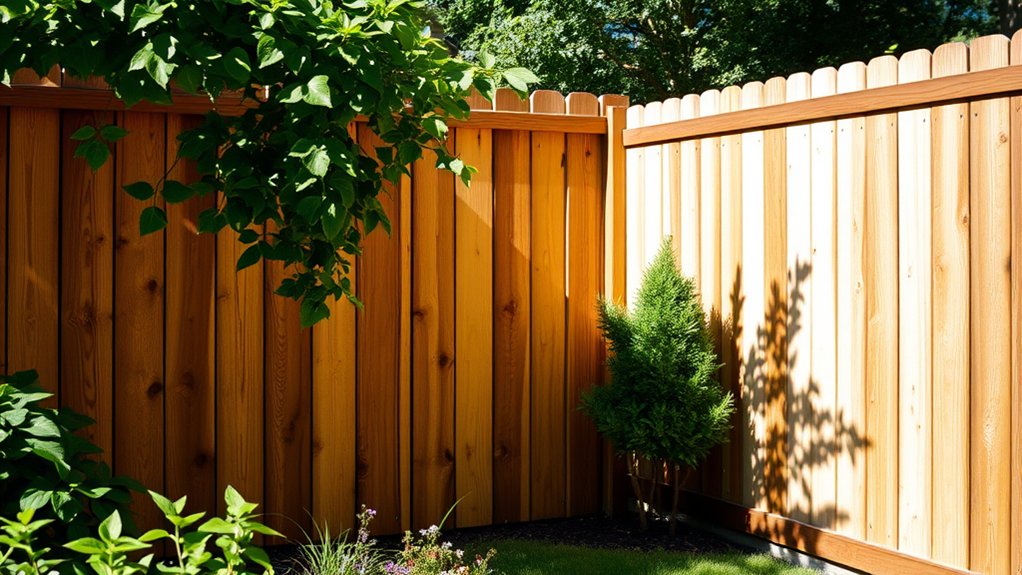
Wood fencing provides a classic look that can enhance your property’s appeal. Its natural beauty can be tailored to fit your style, whether you prefer picket or privacy designs.
Different wood types, like cedar and pine, each offer unique features. Adding decorative elements like lattice tops or post caps can make your fence stand out even more.
The rustic charm of wood’s grain connects well with outdoor spaces, adding character. Plus, as wood weathers, it gains a unique look that can boost your home’s curb appeal and value.
With proper care, your wood fence will maintain its beauty for years.
Installation Process for Composite Fencing
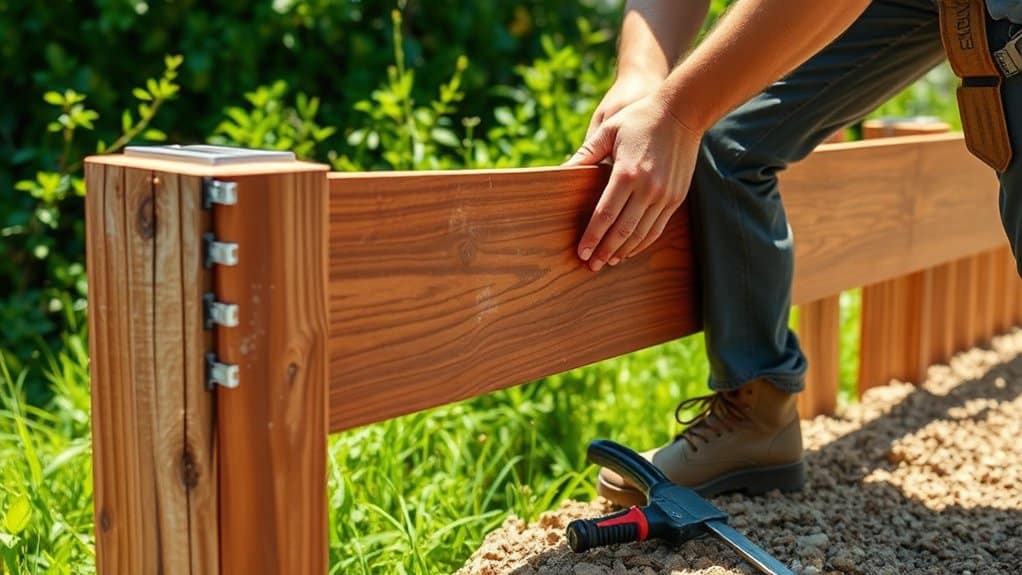
Before starting the installation of composite fencing, it’s crucial to plan ahead. Here’s a simple checklist to ensure a smooth process:
- Measure your yard to find out the total fence length and how many posts you’ll need.
- Choose compatible posts that work with your composite panels.
- Gather necessary tools, such as a post hole digger and concrete mixer.
- Review local regulations to ensure your installation meets all codes.
After these preparations, dig post holes at least one-third the height of the fence for stability.
Use concrete to secure the posts, spacing them 4 to 6 feet apart for optimal strength.
Installation Process for Wood Fencing
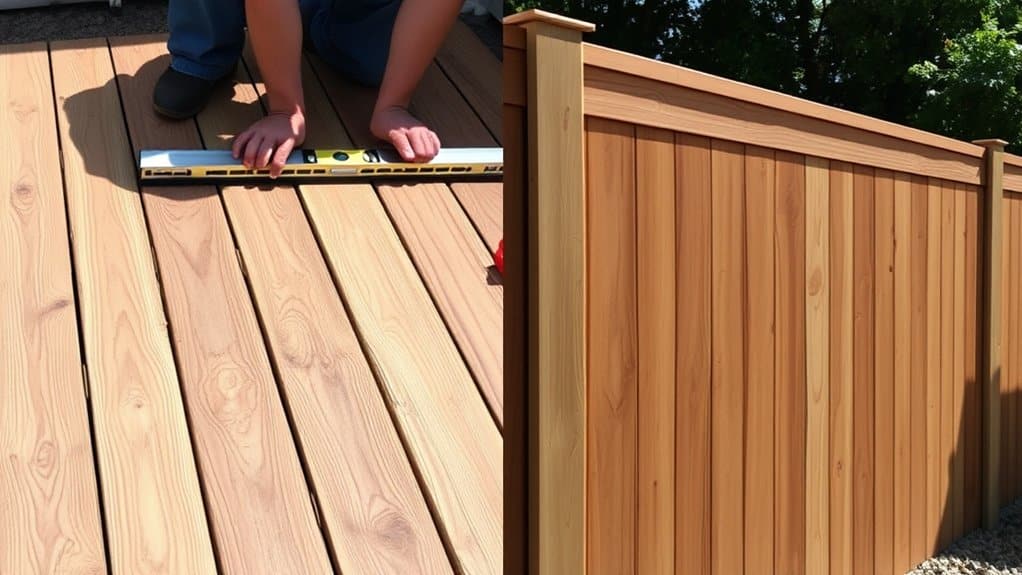
Installing wood fencing is straightforward if you follow these essential steps. First, check your local regulations and permits to avoid any issues down the line.
Before you start, mark any utility lines to prevent damage. Clear the area of debris, measure, and mark where your posts will go.
Dig the post holes and add gravel for drainage. Set the posts in concrete, ensuring they’re level.
Once the concrete is cured, attach the horizontal rails. Next, affix the pickets, spacing them evenly. Trim them to the same height for a neat look.
To protect your fence, add post caps and apply sealant or stain. Regular inspections and maintenance will also help extend the life of your fence.
Frequently Asked Questions
How Do Composite and Wood Fences Perform in Extreme Weather Conditions?
In extreme weather, composite fences outperform wood by resisting warping and cracking. This durability means they stay intact longer, making them a reliable choice for harsh climates. For instance, while wood may splinter or rot after heavy rain or snow, composite fences maintain their strength and appearance, saving you time and money on repairs.
Can Composite Fencing Be Recycled at the End of Its Life?
Yes, composite fencing can be recycled at the end of its life. Recycling helps reduce waste and conserve resources, making it an eco-friendly choice for homeowners. For example, instead of ending up in a landfill, the materials can be repurposed into new products, benefiting the environment.
What Warranty Options Are Available for Composite and Wood Fencing?
Composite fencing typically comes with extensive warranties that can last for decades, offering solid protection for your investment. In contrast, wood fencing warranties are usually less comprehensive. To keep these warranties valid, it’s essential to follow maintenance guidelines, which helps safeguard against common issues like decay or damage.
Are There Color Options for Composite Fencing That Resist Fading?
Yes, composite fencing comes in colors that resist fading. Options like Saddle and Winchester Grey are designed to stay vibrant with little maintenance over time.
How Do Pests Affect Composite Versus Wood Fencing Durability?
Pests can severely damage wood fencing, leading to rot and requiring regular upkeep. For example, termites can quickly weaken wooden posts. On the other hand, composite fencing is much more resistant to pests, which means it suffers less damage and lasts longer without needing constant maintenance.
Conclusion
When choosing fencing, composite materials tend to last longer and require less maintenance than wood. While wood has a classic look, it needs regular care to keep it looking good. If you want a durable and low-maintenance option, composite fencing is a great choice. However, if you love the natural look of wood, its timeless appeal might still attract you.

